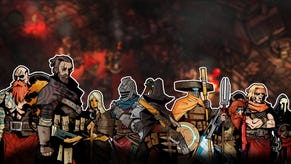Never Mind The Last Of Us, Here's The Real Game With The First LGBT+ Protagonist
In 1989, a lone developer released the LGBT+ detective game Caper in the Castro.
This article first appeared on USgamer, a partner publication of VG247. Some content, such as this article, has been migrated to VG247 for posterity after USgamer's closure - but it has not been edited or further vetted by the VG247 team.
The Last Of Us Part 2 arrived with aplomb last month, instantly solidifying itself as the front runner for Game Of The Year and making a late dash for the Game Of The Generation. It's a game which brought with it endless thrills, endless bloodshed and, unfortunately, endless discourse. One such element of this discourse is the queer representation of the game, not only being led by a lesbian in Ellie, but also featuring bisexual and transgender characters in Dina and Lev. These depictions have been praised and criticised in equal measure, both for how the characters have been presented within the game themselves, and on whether Naughty Dog should be the ones to tell this story.
As a trans woman myself, I've written about the importance of the trans representation within The Last Of Us Part 2, noting that, while imperfect, the trans narrative within the game is both relatable and a net-positive for the industry. However, in Paste, Waverly wrote that the trans presentation was offered up through the lens of cisgender voyeurism; a criticism that, despite my own praise for the trans narrative, I broadly agree with. As Kenneth Shepard noted, queer spaces are not a monolith, and it should not be surprising that such prominent queer characters and narratives have led to different interpretations.
Perhaps the strangest discourse however has been the discussion over whether The Last Of Us Part 2 counts as the first game to have an LGBT+ protagonist. In pure triple-A gaming, it is a rarity to see such inclusion, especially when it comes to the player character. However, to label it as such tramples over the work other smaller studios have been doing for decades, and further aggravates the debate on whether Naughty Dog should be the ones to tell these stories in the first place. In just the past few years, Dontnod gave us a bisexual lead in Life Is Strange's Max Caulfield, and Matt Makes Games offered up a transgender protagonist in Celeste's Madeline. Neither of these qualify as the first either, however. In fact, that title seems to belong to the 1989 point-and-click adventure, Caper In The Castro.
In 1989, the Reagan administration flowed into the Bush administration and 21,000 men died from AIDS; a figure up 5,000 from the previous year and set to rise steadily to a peak of over 41,000 by 1995. In New York City, the disease was so destructive that it was the leading cause of death in the city for young men of any race and for young Black women. These are not tangential facts for events which happened to occur in the same year as Caper In The Castro released; they are crucial to understanding not only the queer environment the game was introduced into, but the very reason it came into existence in the first place.
Caper in the Castro was developed by C.M. Ralph over the course of a year, with Ralph working on the game during her free time while maintaining a full-time Silicon Valley job. Developed on Mac OS, the game was then distributed freely on LGBT-centric bulletin board systems as charityware to help fund the AIDS crisis. Upon downloading the game, players were prompted to donate money to an AIDS foundation of their choice. In a 2014 interview with Paste, Ralph explained her reasons for developing the game; "In 1988 I had moved from Southern California (behind the orange curtain) to the San Francisco Bay Area. I was so impressed and grateful for the freedom of the LBGT community here as compared to what I had lived in down in SoCal. I wanted to give back to the community and also create a way to raise money for AIDS Charities."
Deaths from AIDS rose steadily in the United States from 1984 onward, with President Reagan facing continued pressure from LGBT+ rights groups to act. His administration passed no legislation whatsoever regarding LGBT+ individuals, and when his Press Secretary Larry Speakes was asked for comment on the AIDS crisis in 1984 (when deaths in the USA stood at some 4,200), Speakes laughed, insinuated the reporter who asked the question was a homosexual, and declined to answer. Though gay men were not the only sufferers of HIV/AIDS—needle sharing among drug users was another large factor in the crisis—the disease was known colloquially as 'the gay plague.' Any attempt to quell the disease was considered tantamount to support for the gay community. As a result, both the Reagan administration and the Bush administration turned their backs on the crisis.

That the U.S. government failed to act decisively does not just highlight why charitable efforts to combat HIV/AIDS were so necessary, it also illustrates the environment LGBT+ people lived in during the 1980s. Through a deliberate lack of legislation and assistance, the state created an 'Us Vs. Them' narrative against the gay community, depicting them as perverts whose suffering was punishment for their own sexual deviance. In fact, until 1990, immigrants could be denied entry to the U.S. on the ground of 'sexual deviance'; a.k.a. homosexuality.
It's within this 'Us Vs. Them' narrative that Caper In The Castro thrives. It's a game very much for and about the 'Them,' loaded with queer characters, imagery, and inside jokes. Though it was created to be shared within the LGBT+ community rather than to make a statement of activism to the wider world, its very existence is an act of rebellion. Marketed under the taglines 'Finally... a game for the rest of us!' and 'It's not just a game, it's a gay-me!', Caper In The Castro's queerness is bold and proud, in an era where the community was encouraged to hide in shame.. "It was embraced and enjoyed," Ralph told Paste in 2014, "At the time, seen as quite an innovative breakthrough."
The point-and-click mystery game casts you as 'world famous lesbian detective, Tracker McDyke,' who's uncovering who could have kidnapped your old friend, 'drag queen Tessy LaFemme.' It's set in the Castro, San Francisco's most prominent gay district. The villain of this tale? The gloriously named 'Dullagan Straightman.' Armed with a lockpick, lighter, notepad, magnifying glass, and gun, you must uncover the whereabouts of Tessy, but in searching for her you stumble upon a larger, more complex and sinister plot.
Straightman's larger plan is to infect the alcohol at the game's gay bar—The Gayme—with a fast acting, poisonous bacteria designed to wipe out the Castro's gay population; a clear allegory for the AIDS crisis in general. In order to solve the crimes, you must select which piece of equipment you wish to use, then type in what you use it on. Despite the technological limits, Caper In The Castro has various creative beats, such as requiring you to damage a toilet so the bathroom floods, then swimming through the rising water to the vent, before shooting the screws off.

The AIDS parallel isn't just a vague background to this gritty, noir-ish tale either—the game places it right at the center. Drinking the house wine in The Gayme results in the message 'The House Wine has been tainted with a deadly, fast-acting bacterial virus. You are about to die and there is no antidote. Sorry,' parodying the lack of care or sympathy the government offered toward AIDS sufferers of the era. Caper In The Castro takes the 'Us Vs. Them' environment the world had created for queer people in the late '80s and inverts it.
It's not just as the first LGBT+ led video game that Caper In The Castro warrants recognition. The game was developed in HyperCard, a tool which was originally designed for business purposes before Ralph figured out it could be useful for creating text-based games. This proved to be so successful that a few months after Caper In The Castro's release, Ralph straightwashed the game, renaming it Murder On Main Street, and sold it to Heizer Software. In this straight version, Tracker McDyke is now Tracker MacDuff, drag queen Tessy LaFemme is now supermodel Tessy LaRue, Dullagan Straightman is now Dullagan Strongarm and gay bar The Gayme is now a straight bar called The Game. Speaking to LGBTQ Game Archive, Ralph admitted she'd always found it rather funny that the mainstream market had no idea of how queer the game really was, "It always cracked me up that these people were loving this game and buying it and had no idea it was actually an LGBT game."
Though Ralph made the decision herself to straightwash the game, the fact she knew the game wouldn't get traction if it kept the gay themes speaks to the ways popular culture has frequently stolen from queer culture, stripped out its queer roots, and commodified it. The same year Caper In The Castro/Murder On Main Street released, Madonna took voguing from the Harlem ball scene (itself the topic of the seminal LGBT+ documentary Paris Is Burning) and was credited by the mainstream with its invention. Pop music has a long history of similar iconographic theft, and the lexicon of the queer scene, in particular queer Black women, has frequently been transplanted into pop culture without a trace, from 'shade' to 'bae.'
Recently, as LGBT+ acceptance appears to have passed the tipping point so that being anti-gay is now more damaging to one's reputation than being pro-gay, brands fall over themselves to cover their logos in rainbow flags every Pride month, but few follow this up by centering queer voices or donating proceeds to queer causes.

For years, Caper in the Castro was thought to be lost, with Ralph losing trace of the original floppy disk copies of both Caper In The Castro and Murder On Main Street. However, in 2017, Ralph located both disks in the process of moving house, and after a discussion with Adrienne Shaw from the LGBTQ Video Game Archive, both versions were uploaded to the Internet Archive and are currently playable here and here.
However you feel about The Last Of Us Part 2, it's undeniable that the game is going to stick around for a long time, doomed to endless cyclical praise as part of the Best Games Of The Year, Decade, Generation roundups. Despite the existence of Caper In The Castro, '90s era queer games like Gayblade, Foobar Vs. The DEA and Orion Conspiracy, or even modern mainstream yet smaller games like Life Is Strange and Celeste, it is probably destined to be remembered as the first game to have an LGBT+ protagonist, by virtue of being the first critically adored, triple-A game to have an LGBT+ protagonist.
However, it's crucial that we recognize that gaming has a long and rich queer history. Other games have ran the relay race Naughty Dog are getting the credit for crossing the finish line of, and that representation cannot stop with a single queer white protagonist. The Last Of Us Part 2 is important, but it must be viewed as a stepping stone in a long line which stretches back much further, and will hopefully continue to extend forward, in the path of queer representation in video games.










